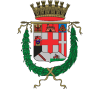The building, which is private property and can only be seen from outside, was home to the tyrant Ezzelino da Romano, Lord of Vicenza, Verona and Padua in the first half of the thirteenth century . A supporter of the emperor Frederic II, his backing of the Ghibellines (who argued that supreme secular power lay with the emperor not the pope) led to him being excommunicated by Pope Innocent IV. Combining courage and ruthless daring, Ezzelino was skilful in exploiting the needs of the emperor for his own personal ends: relentless in extending his dominions, he soon acquired the nickname “the terrible” because of his thirst for power and his ruthlessness when dealing with any threats to his position. This reputation meant that, over the years, acts of all sorts of cruelty have been attributed to him.
Work on the original Palazzo di Ezzelino began in the twelfth century, but the present-day appearance of the building would seem to date from the following century: evidence for this can be seen in its similarities with other buildings dating from the period of the Commune, and in the elegant two-light window on the first floor. Crowned with a crest in Vicenza stone dating from the fifteenth century, the building would be damaged by fire in 1760; and we know that in the years 1794-1873, the space above the wide facade vault was used as a theatre.
To the right of the palazzo – and of the facade vault that is also known as the Malvasia Vault – is a bronze plaque that commemorates Falvio Busonera, a member of the Resistance who was hanged here in 1944.
- DISCOVER
- LIVE
FOCUS
- GET INSPIRED
FOCUS
- INFO
- BOOK NOW












